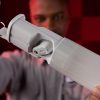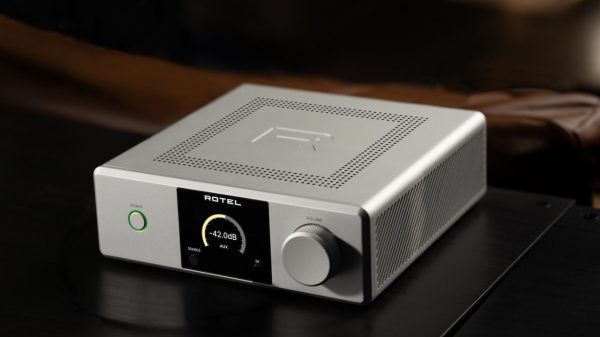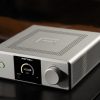Cyrus is a very interesting British audio manufacturer that doesn’t receive a lot of press coverage in North America; a reality that is starting to change because it’s hard to keep a secret for over thirty years. Very much like Croft Acoustics; another British manufacturer with a cult following, Cyrus have been engineering some of the best hi-fi in the world for over 30 years but without a a lot of fanfare. The British press fall over themselves to review their extensive range of products and it’s rare to see any component not receive a “rave” review. The Cyrus One HD Integrated Amplifier hopes to continue that streak.
I have owned and enjoyed an original Cyrus One in the past so when a press tour of the new One HD was announced, I requested that I be included. The pandemic has created a shortage of review samples, but I did manage to hold onto the Cyrus One HD for more than 2 weeks and it was beyond informative. Thank you America HiFi for providing my review unit.
Upon arrival, one notices a good heft as the Cyrus One HD is a large unit and as such comes packed for travel and not for a retail shelf. The unit was well packed in form-fitted foam blocks with the manual, driver CD, and power cable all well packed into a separate box in the shipping container to avoid contact with the unit and scratches that might occur as a result.
If purchasing the One HD, please note that no interconnects are provided with the unit so sets of RCA cables, a USB, optical or coax cable for inputs, and a set of speaker cables will be needed to complete the installation.
The unit does not ship with a remote either, but does have an app available on the Google Play Store and the Apple App Store for use with the unit.
The Cyrus One HD Integrated Amplifier / DAC joins a growing and very crowded field of amplifiers designed for the digital streaming world; the $1,499 unit faces some stiff competition from Cambridge Audio, NAD, Bluesound, Marantz, and Rotel below $1,500.
Like its older sibling, the Cyrus One HD is a fairly plain looking amplifier. It is roughly half the width (but the same depth) of most full-sized audio components with a heavy metal frame and chassis.

The top cover lifts off easily to expose the internal components by removing 6 star head screws. The two front screws also lock the faceplate into position as once the screws are pulled the faceplate lifts out of slots in the metal frame and is connected to the main board by ribbon cable which makes the internals easy to access for cleaning or should maintenance be required.
The faceplate itself is plastic and high gloss while the remaining shell is powder coated, with a more matte satin finish. There are two large knobs on the front panel that have a partial circle of LEDs surrounding them.

The left knob is the selector and the right is volume control. The power button is tucked beneath the left knob while the headphone jack is at the far right beneath the volume dial.
The real panel is quite busy; speaker binding posts (dual type banana/spade) occupy both outside edges with the power cord receptacle and inputs occupying the middle space.
The Cyrus One HD includes USB, coaxial, and optical digital inputs, as well as 3 RCA inputs, a MM phono stage input with ground connector, and a single pair of RCA outputs.

The decision to include all 3 digital inputs makes a lot of sense and bucks a recent trend to only include optical and coaxial on some of the units I’ve seen. If you use a network streamer or laptop with a USB output, the Cyrus One HD is ready to play.
The other prominent feature is a single heavy bolt through the center bottom of the chassis that mounts the monster-sized toroidal transformer that is the heart of the linear power supply used in the One and One HD amplifiers.
The One HD’s internals are less crowded than one might expect with the number of different features the One HD packs in. It starts with the previously mentioned large toroidal transformer that feeds the power circuitry and feeds everything else hiding inside.

The digital inputs feed a Burr Brown 17xx series DAC chip which allows the USB input to handle up to 32-bit/192kHz. The coaxial and optical inputs are able to handle up to 24-bit/192kHz as well.
In addition, the Cyrus One HD Integrated Amplifier also supports Bluetooth AptX HD.
Regardless of which input you select, they are fed to a class D power amplifier circuit of Cyrus’ own design if using the speaker outputs or to a class A/B amplifier if using the headphone jack. That’s an important distinction to remember.
The speaker taps also utilize an impedance sensing mechanism. This can be thought of as a feedback loop where a micro-controller analyzes the high frequency impedance of the connected speaker and adjusts to match the impedance requirement to improve performance.
This is one of the criticisms of class D amplification; the reconstruction filters in class D tend to cause impedance mismatches and deviations.
That mismatch is why speakers like my Maggies (Magnepan) are not huge fans of class D amplification.
The Cyrus One HD, although a little light on power at a 100 watts per channel, can indeed be used safely with speakers like Magneplanars, and actually drove them a bit better than I had expected.
Even a computer controlled impedance matching system has its limits though, and with speakers generally ranging between 4 and 16 ohms, it is not realistic to expect that same circuit to be optimized for headphone use.

So instead of even trying to tune the class D system to handle 600 ohm AKGs, or 300 ohm Sennheisers, the One HD instead redirects the power to a class A/B headphone amplifier that is more suited to the task at hand.
The One HD also includes a mini-USB connector on the rear for servicing or updates so as improvements to the micro-controllers code become available, the One HD can take full advantage rather than becoming obsolete.
Where we part ways with the Cyrus One of old is the remote. The older model came with a remote that was fairly simple and uncluttered and gave the user quick access to switch sources or adjust volume.
With the One HD offering Bluetooth aptX HD, it makes perfect sense that the remote would vanish and one could control all of the functions via a control app.
You can download the Cyrus One Remote app from the Google and Apple stores and it gives the user the same capabilities of the physical remote.
Pairing the Cyrus One HD very straightforward and connectivity was quite good once established. With my LG phone using AptX HD, latency was minimal and I only lost connection to the One HD when line of sight was lost and obstacles blocked the signal. Pairing a new source was equally easy once the connection from the previous source was dropped.
The Sound
Having owned the older Cyrus One, I had some expectations in regard to what I expected to hear and for the most part, those proved to be correct.
The Cyrus One HD has good resolution and power as long as it is not matched with something too far outside its comfort zone. Although I did try it with my Maggies, I conducted most of my critical listening with a pair of Klipsch Heresy II loudspeakers which proved to be a much better match.
The One HD has a very clean, detailed sound with good texture and enough body to give vocals a natural weight to them. The best part is that the Cyrus One HD does seem to vanish into the background and picking out any unwanted colorations was quite difficult.

Another aspect of its presentation that I did notice, was that the sound really didn’t change very much when I switched between the 3 digital inputs. I’ve heard some substantial differences between some DACs and amplifiers with digital sections depending on the choice of input and that was not the case here.
Dynamics are good but not the strongest aspect of the One HD’s presentation. We’re not taking about a Levinson or Pass Labs amplifier and one should not forget that this is a $1,500 amplifier, DAC, pre-amplifier, and headphone amplifier in one box.
Get the speaker correct, and the Cyrus One HD Integrated Amplifier will not disappoint with any genre of music.
But What About Headphones?
A lot of manufacturers like to stick a headphone amplifier into everything they make in 2021, but that doesn’t make them very good.
The Rega io Integrated Amplifier has a rather competent headphone amplifier if you’re not using difficult headphones, and the Cyrus One HD doesn’t disappoint either.
When switching to the headphone amp, many of the same qualities that made the One HD so enjoyable with speakers were quite evident with headphones.
Detail is very good with a lot of texture and nuance to the sound; there is definitely more coloration to the sound in comparison to with my Klipsch speakers.

With headphones, the One HD does show a slight upper-midrange lift that translates into female vocals being slightly in front of their male counterparts. I didn’t find the extra emphasis distracting though as it is fairly small and if anything it did make the One HD a better choice for vocal music and choral arrangements which benefitted from the enhanced presence in the soundstage.
There is plenty of headroom here and dynamic range, so the issue on the speaker taps may be more my choice of speaker than anything inherent to the One HD.
Interestingly, the One HD shares the same DAC family with both my Bel Canto DAC in my home system and with the iFi Audio iDSD Neo that I recently reviewed.
The Bel Canto sounds more analytical and has less coloration than either the One HD or the Neo, which both sport a similar lift in the upper midrange. The One HD splits the difference in clarity between the Neo which loses a little detail to musicality, and the Bel Canto that is a bit more revealing but also a bit less forgiving of poorly recorded music.
It’s fascinating how three different devices using the same DAC chip sound so different.
Conclusion
The Cyrus One HD Integrated Amplifier has to be looked at holistically to be fully appreciated. The amp alone is quite good, but not quite as good as some at the $1,500 price point. Likewise, the phono stage is good, but can be bettered by other stand alone pre-amps. The headphone amp is impressive but again not as good as a dedicated headphone amplifier.
It is the overall performance of the entire package that makes the Cyrus One HD so intriguing. $1,500 is not an insignificant amount of money for a single component if you’re building a $3,000 stereo system.
The Cyrus One HD brings solid performance in every category to the table in a one-box solution that will work with a lot of loudspeakers in the $500 – $1,000 range.
If you don’t listen to vinyl and only want to use a network streamer like the Bluesound NODE, one could easily assemble an excellent sounding system around the Cyrus One HD and a pair of loudspeakers from Wharfedale, Elac, Polk Audio, or PSB and come away very satisfied.
Adding a turntable will add a minimum of $500 to the cost of the system, but Cyrus have a reputation for excellence in regard to their dedicated phono preamps — so you’re not going to suffer with its internal phono section.
The Cyrus One HD is a solid choice for a system in a smaller room, office, or bedroom and a very solid performer.
For more information: cyrusaudio.com/products/cyrus-one-hd/
Where to buy: $1,499 at America HiFi | $1,499 at Amazon | £839 at Amazon.co.uk
A sincere thanks to America HiFi for providing the Cyrus One HD on loan.

































